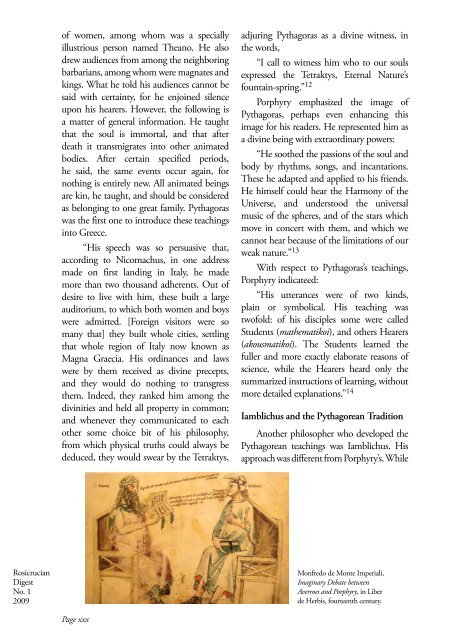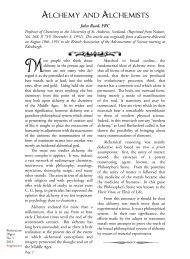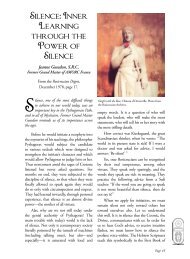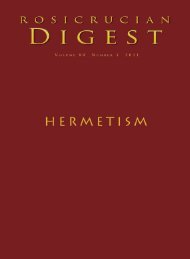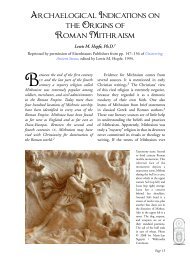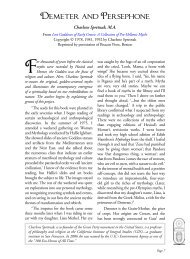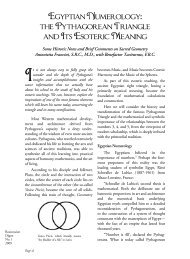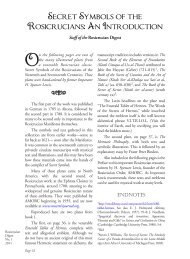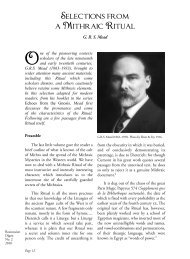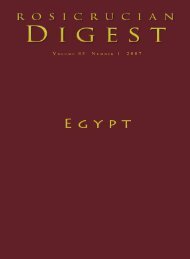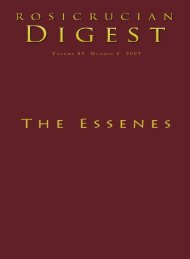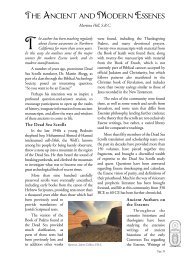Pythagorean Teachings across the Centuries - Rosicrucian Order
Pythagorean Teachings across the Centuries - Rosicrucian Order
Pythagorean Teachings across the Centuries - Rosicrucian Order
You also want an ePaper? Increase the reach of your titles
YUMPU automatically turns print PDFs into web optimized ePapers that Google loves.
of women, among whom was a specially<br />
illustrious person named Theano. He also<br />
drew audiences from among <strong>the</strong> neighboring<br />
barbarians, among whom were magnates and<br />
kings. What he told his audiences cannot be<br />
said with certainty, for he enjoined silence<br />
upon his hearers. However, <strong>the</strong> following is<br />
a matter of general information. He taught<br />
that <strong>the</strong> soul is immortal, and that after<br />
death it transmigrates into o<strong>the</strong>r animated<br />
bodies. After certain specified periods,<br />
he said, <strong>the</strong> same events occur again, for<br />
nothing is entirely new. All animated beings<br />
are kin, he taught, and should be considered<br />
as belonging to one great family. Pythagoras<br />
was <strong>the</strong> first one to introduce <strong>the</strong>se teachings<br />
into Greece.<br />
“His speech was so persuasive that,<br />
according to Nicomachus, in one address<br />
made on first landing in Italy, he made<br />
more than two thousand adherents. Out of<br />
desire to live with him, <strong>the</strong>se built a large<br />
auditorium, to which both women and boys<br />
were admitted. [Foreign visitors were so<br />
many that] <strong>the</strong>y built whole cities, settling<br />
that whole region of Italy now known as<br />
Magna Graecia. His ordinances and laws<br />
were by <strong>the</strong>m received as divine precepts,<br />
and <strong>the</strong>y would do nothing to transgress<br />
<strong>the</strong>m. Indeed, <strong>the</strong>y ranked him among <strong>the</strong><br />
divinities and held all property in common;<br />
and whenever <strong>the</strong>y communicated to each<br />
o<strong>the</strong>r some choice bit of his philosophy,<br />
from which physical truths could always be<br />
deduced, <strong>the</strong>y would swear by <strong>the</strong> Tetraktys,<br />
adjuring Pythagoras as a divine witness, in<br />
<strong>the</strong> words,<br />
“I call to witness him who to our souls<br />
expressed <strong>the</strong> Tetraktys, Eternal Nature’s<br />
fountain-spring.” 12<br />
Porphyry emphasized <strong>the</strong> image of<br />
Pythagoras, perhaps even enhancing this<br />
image for his readers. He represented him as<br />
a divine being with extraordinary powers:<br />
“He soo<strong>the</strong>d <strong>the</strong> passions of <strong>the</strong> soul and<br />
body by rhythms, songs, and incantations.<br />
These he adapted and applied to his friends.<br />
He himself could hear <strong>the</strong> Harmony of <strong>the</strong><br />
Universe, and understood <strong>the</strong> universal<br />
music of <strong>the</strong> spheres, and of <strong>the</strong> stars which<br />
move in concert with <strong>the</strong>m, and which we<br />
cannot hear because of <strong>the</strong> limitations of our<br />
weak nature.” 13<br />
With respect to Pythagoras’s teachings,<br />
Porphyry indicateed:<br />
“His utterances were of two kinds,<br />
plain or symbolical. His teaching was<br />
twofold: of his disciples some were called<br />
Students (ma<strong>the</strong>matikoi), and o<strong>the</strong>rs Hearers<br />
(akousmatikoi). The Students learned <strong>the</strong><br />
fuller and more exactly elaborate reasons of<br />
science, while <strong>the</strong> Hearers heard only <strong>the</strong><br />
summarized instructions of learning, without<br />
more detailed explanations.” 14<br />
Iamblichus and <strong>the</strong> <strong>Pythagorean</strong> Tradition<br />
Ano<strong>the</strong>r philosopher who developed <strong>the</strong><br />
<strong>Pythagorean</strong> teachings was Iamblichus. His<br />
approach was different from Porphyry’s. While<br />
<strong>Rosicrucian</strong><br />
Digest<br />
No. 1<br />
2009<br />
Monfredo de Monte Imperiali,<br />
Imaginary Debate between<br />
Averroes and Porphyry, in Liber<br />
de Herbis, fourteenth century.<br />
Page xxx


